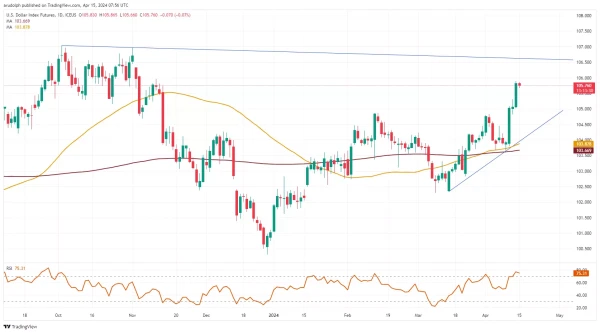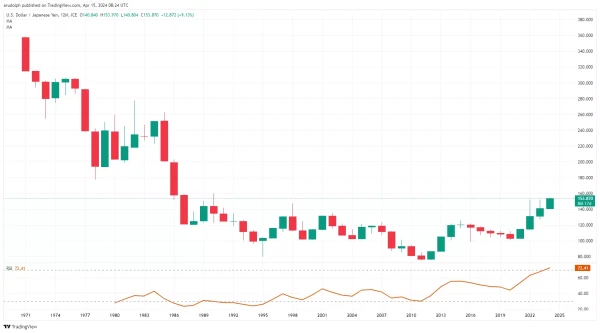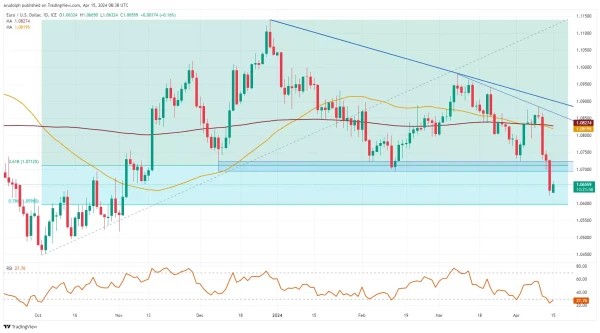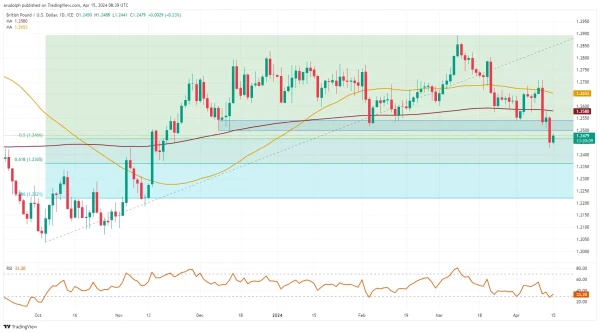US dollar strength is here to stay: USD/JPY targets ¥160.16, EUR/USD $1.0449, GBP/USD $1.2200 region
The US dollar trades in five-month highs and has further upside in store
A robust US labour market, sticky inflation, pushed back US rate cut expectations, and escalating tensions in the Middle East have led to a 3.5% rally in the US Dollar Basket over the past six weeks.
According to technical analysis, further greenback appreciation is also on the cards with the October-to-November highs at 106.98 to 107.05 being eyed.
US Dollar Basket Daily Candlestick Chart


The fact that the US economy added 303K jobs in March 2024, the most in ten months, coupled with Consumer Price Inflations (CPI) coming in slightly higher-than-expected at 3.5% versus a 3.2% year-on-year increase in February, pushed US yields to five-month highs and led to the greenback appreciating.
Meanwhile US Federal Reserve (Fed) rate cut expectations have been pushed back from June and three rate cuts this year to September and two rate cuts, also boosting the greenback. This is because higher rates for longer make holding the US dollar more attractive than other currencies such as the euro of the British pound, for example, with the former expected to cut rates in June and the latter in August.
The missile and drone attacks by Iran on Israel over the weekend have led to flight-to-safety flows into the US dollar, leading to further appreciation of the currency.
The yen, despite investors expecting to see another rate hike at the Bank of Japan’s (BoJ) July monetary meeting, continues to take the brunt and is further depreciating versus the US dollar, hitting yet another 34-year high whilst on its way to its 1990 peak at ¥160.16.
USD/JPY Yearly Candlestick Chart


USD/JPY is thus on track for its fourth straight year of gains with further upside expected to be seen in the course of this year.
Versus the euro, the US dollar is also expected to appreciate further.
Last week’s fall through and weekly chart close below EUR/USD’s key $1.0725 to $1.0695 support zone, made up of the December-to-early April lows, is technically bearish and puts the October low at $1.0449 on the map. En route lies the 78.6% Fibonacci retracement of the October-to-December advance at $1.0596.
This bearish scenario will remain in play while no bounce in the cross takes it to above the major $1.0695 to $1.0725 resistance area.
EUR/USD Daily Candlestick Chart


The technical picture is similar when it comes to GBP/USD, even though it is currently flirting with the 50% retracement of the October-to-March advance.
Nonetheless the currency pair also fell through its key support at $1.2540 to $1.2500, which encompasses the December-to-early April lows, and thus points towards further weakness towards the October-to-November lows at $1.2096 to $1.2038 unfolding.
On the way down the 61.8% Fibonacci retracement can be found at $1.2365 and represents the next downside target.
Only a rise and daily chart close above the, because of inverse polarity now resistance zone, at $1.2500 to $1.2540, and the 200-day simple moving average (SMA) at $1.2580 would negate the bearish GBP/USD outlook.
GBP/USD Daily Candlestick Chart

